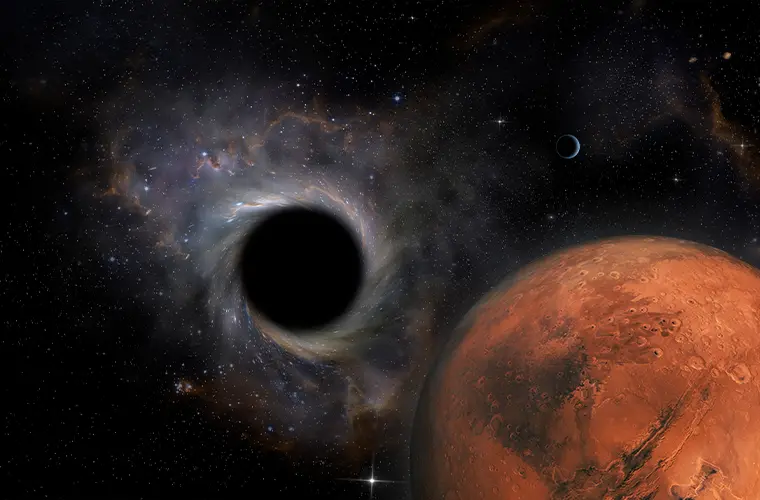Physicists from the Massachusetts Institute of Technology (MIT) have proposed a novel way to find evidence of primordial black holes and dark matter, one of the universe’s most elusive mysteries: by monitoring the motion of Mars.
If successful, the new approach could offer compelling evidence for the long-theorized existence of microscopic black holes, according to findings detailed in a new study.
“Given decades of precision telemetry, scientists know the distance between Earth and Mars to an accuracy of about 10 centimeters,” said a study author and professor of physics at MIT, Dr. David Kaiser, in a press release. “We’re taking advantage of this highly instrumented region of space to try and look for a small effect.”
“If we see it, that would count as a real reason to keep pursuing this delightful idea that all of dark matter consists of black holes that were spawned in less than a second after the Big Bang and have been streaming around the universe for 14 billion years.”
In a paper recently published in the journal Physical Review D, researchers suggest that subtle changes in Mars’s orbit could provide the first physical evidence of primordial black holes and offer insights into the mysterious nature of dark matter.
Primordial black holes (PBHs) are hypothetical black holes thought to have formed in the extreme conditions of the early universe. Unlike the massive black holes that form from dying stars, these microscopic black holes could have masses as small as an asteroid, ranging between 10^17 and 10^23 grams (about the mass of a mountain). Despite their tiny size, primordial black holes are believed to be immensely dense, warping spacetime in their vicinity.
For decades, primordial black holes have been considered a potential explanation for dark matter – a hypothetical form of matter that does not interact with light or electromagnetic radiation.
Since the early 20th century, the existence of dark matter has been inferred based on observed gravitational effects that general relativity cannot explain. However, the true nature of dark matter remains elusive, and it has yet to be directly observed.
In this recent study, researchers from MIT’s Center for Theoretical Physics suggest that monitoring Mars to detect slight “wobbles” or perturbations in its orbit could be the key to proving the existence of primordial black holes and finally solving the mystery of dark matter.
According to researchers, if a primordial black hole were to pass through the solar system, it would exert gravitational forces on planets, causing subtle changes in their orbital paths.
By looking for these anomalies—specifically in Mars’ orbit the researchers say it could be possible to detect primordial black holes and confirm their role as dark matter.
“Primordial black holes do not live in the solar system. Rather, they’re streaming through the universe, doing their own thing,” co-author Dr. Sarah Geller said. “And the probability is, they’re going through the inner solar system at some angle once every 10 years or so.”
The idea is based on the incredible precision with which planetary orbits are measured today. Thanks to decades of observations, including satellite data and laser measurements, the orbits of Mars and other planets in our solar system are mapped with astonishing accuracy—down to the centimeter.
By comparing these measurements with real-time data from Mars orbiters and landers, scientists can look for deviations in the planet’s motion that the known gravitational forces from the Sun or other planets cannot explain.
According to researchers, the passage of a primordial black hole would cause a detectable blip in Mars’ orbit, which current observational technology could pick up. They propose using data from ongoing missions, such as NASA’s Mars orbiters, which have been precisely measuring the planet’s position for over two decades.
Researchers say a fairly innocuous question initially sparked the idea behind this novel approach to detecting primordial black holes.
“I think someone asked me what would happen if a primordial black hole passed through a human body,” lead author Tung Tran recalled.
Tran explained that the chances of a primordial black hole passing anywhere near a person on Earth are “astronomically unlikely.” However, according to his calculations, if a black hole the size of a single atom were to pass within three feet of someone, it would exert enough force to push them about 20 feet away in just one second.
This improbable thought experiment inspired Tran and his colleagues to hypothesize that a primordial black hole passing by could create detectable effects on larger celestial bodies in the universe.
To validate this theory, researchers conducted extensive simulations that modeled the potential effects of primordial black holes passing through the solar system.
These simulations aimed to predict how such encounters would subtly influence the orbits of planets, particularly Mars. By comparing the expected gravitational perturbations caused by primordial black holes with precise data on Mars’ orbit, the team found that such anomalies could indeed be detectable with current or near-future observational technologies.
“State-of-the-art simulations of the solar system include more than a million objects, each of which has a tiny residual effect,” co-author and MIT Pappalardo Fellow Dr. Benjamin Lehmann said. “But even modeling two dozen objects in a careful simulation, we could see there was a real effect that we could dig into.”
Researchers found through simulations that even if a primordial black hole passed within a few hundred million miles of Mars, it would cause a slight “wobble” or deviation in the planet’s orbit. Within a few years of the encounter, Mars’ orbit would shift by about three feet. Although small, this change would be detectable by the high-precision instruments currently monitoring the planet.
Researchers acknowledged that if a wobble in Mars’ orbit were detected, it would be essential to distinguish whether the anomaly was caused by a primordial black hole or something more familiar, like an asteroid.
“We need as much clarity as we can of the expected backgrounds, such as the typical speeds and distributions of boring space rocks, versus these primordial black holes,” Dr. Kaiser explained.
Fortunately, astronomers have been tracking asteroids and other space debris for decades, providing detailed data on their trajectories. By comparing these typical paths and speeds with the distinct behavior expected from a passing primordial black hole, researchers could begin to rule out more mundane explanations.
To further refine their analysis, the team is considering collaborating with experts specializing in simulating a wider variety of objects in the solar system. This partnership would help ensure that any observed deviations in Mars’ orbit are thoroughly examined against all possible causes.
“We are now working to simulate a huge number of objects, from planets to moons and rocks, and how they’re all moving over long time scales,” Dr. Geller added. “We want to inject close encounter scenarios and look at their effects with higher precision.”
This novel approach could finally provide the long-sought-after evidence for dark matter. Despite decades of searching, no direct detection has been made, and scientists have explored a wide range of possibilities—from exotic particles to massive astronomical objects. Primordial black holes are an intriguing candidate because they align with our understanding of the early universe and the nature of dark matter.
Previous methods of searching for dark matter have focused on detecting weakly interacting particles, known as WIMPs, which were predicted by particle physics theories. However, no experiments have yet to detect these particles, leading scientists to consider alternative explanations—such as primordial black holes.
The advantage of the MIT team’s proposal is that it leverages existing technology. With decades of precise data on Mars’ orbit already available and ongoing missions continuing to gather more, scientists may not need to launch new, expensive missions to hunt for dark matter. Instead, the answer might already be hiding in the data we have.
This method could open a new avenue for studying the universe if successful. Not only would it offer direct evidence of primordial black holes and their role in dark matter, but it could also provide new insights into the universe’s formation.
Primordial black holes are believed to have formed in the very early universe, long before stars and galaxies. Finding them would help scientists understand the universe’s conditions in its infancy.
Moreover, detecting dark matter in this way would reshape cosmology. It would confirm that much of the universe’s mass is made up of black holes that have been hidden from us for billions of years, providing a more straightforward explanation for dark matter than exotic particles that have yet to be discovered.
Ultimately, there is still a long way to go before we can definitively claim the discovery of primordial black holes or dark matter. However, this new MIT study offers a promising new direction and suggests that by looking to Mars, we might finally be able to solve one of the universe’s greatest mysteries.
As researchers conclude, “By using decades of high-precision tracking data from various Solar System observing programs, combined with expertise already at hand within the Solar System dynamics community, the intriguing possibility that DM [dark matter] consists of PBHs [primordial black holes] may soon be investigated within our own Earthly neighborhood—adding a novel search strategy to the decades of direct-detection efforts that have been devoted to finding a well-motivated DM [dark matter] candidate.”
Tim McMillan is a retired law enforcement executive, investigative reporter and co-founder of The Debrief. His writing typically focuses on defense, national security, the Intelligence Community and topics related to psychology. You can follow Tim on Twitter: @LtTimMcMillan. Tim can be reached by email: tim@thedebrief.org or through encrypted email: LtTimMcMillan@protonmail.com

